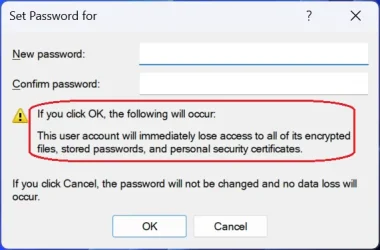If I (using an administrator-enabled account) try to reset another user's password in "Computer Management", I get a dialog box with dire warnings that "Resetting this password might cause irreversible loss of information"
Does anyone know what kind of information loss this is referring to? Does it wipe their entire user profile? Just any stuff related to a Microsoft account? Something else?
Also, is this information loss intrinsic to changing a password, or dependent on what tool I use to change the password? I.E. can I get around this by using the "net" command to change the password, or some more hacker-ish method? (regedit?)
In this scenario:
Does anyone know what kind of information loss this is referring to? Does it wipe their entire user profile? Just any stuff related to a Microsoft account? Something else?
Also, is this information loss intrinsic to changing a password, or dependent on what tool I use to change the password? I.E. can I get around this by using the "net" command to change the password, or some more hacker-ish method? (regedit?)
In this scenario:
- I don't know their password/pin
- I don't have answers to "security questions"
- I don't have a password recovery disk
- This is Windows Professional, but there is no Active-Directory domain.
My Computer
System One
-
- OS
- .










